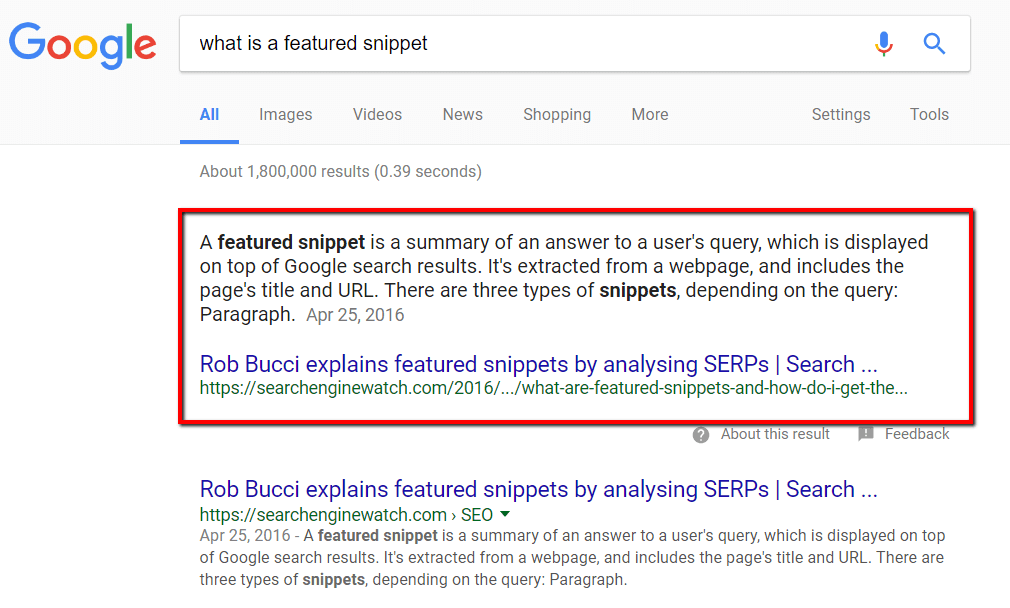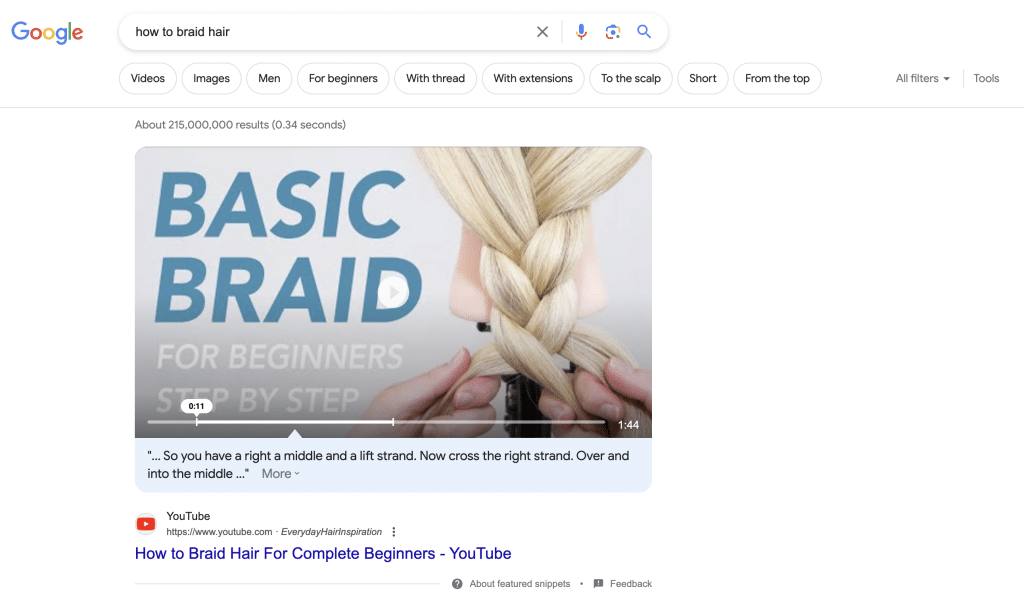
6 Types of Featured Snippets You Should Aim For
Have you ever typed a question into Google and received a direct answer right at the top of the results? That’s a featured snippet.
At Marketing Insider Group, we’ve watched as these snippets have transformed the way users interact with search engines. They’re not just regular search results, but rather concise, direct answers to user queries, prominently displayed above all other results.
Why is this so crucial for businesses like yours and ours? Because these snippets grab attention instantly. In fact, featured snippets account for a staggering 35.1% share of all clicks. When your content becomes the answer in one of these snippets, especially among the various types of featured snippets, you’re not just providing information, but also building trust and authority.
In a modern age where attention spans are short, and competition is fierce, securing that top spot can make all the difference. Join us as we dive deeper into types of featured snippets and why they’re a game-changer in digital marketing.
1. Paragraph
You’ve probably seen these types of featured snippets before. When you ask Google a question, often you’ll get a concise answer in a small box. That’s a paragraph snippet. It’s a brief response to a user’s query.

Image Source: Volume Nine
For any business, this is a golden opportunity. Why? Because if your content nails the answer, Google might just showcase it, leading to more exposure to your content. So, when creating content, aim to answer questions directly and succinctly.
2. List
Ever searched for a step-by-step guide or a list of items? Google loves presenting these as list snippets. They can be ordered (like “steps to bake a cake”) or unordered (like “top vacation destinations”).

Image Source: Google
We’ve found that clear, well-structured lists in our content often catch Google’s eye. Next time you’re writing, think about how you can present information in a list format. It might just land you that coveted snippet spot.
3. Table
Data speaks volumes, especially when it’s well-organized. Table snippets are Google’s way of presenting structured data. Let’s say you’re looking for a comparison or statistics. A table snippet might just pop up.

Image Source: One2create
We always recommend organizing data in easy-to-read tables. Not only does it help our readers, but it also increases our chances of being featured.
4. Video
Videos are powerful. They capture attention and convey information quickly. Google recognizes this and sometimes features video snippets. These are short clips or thumbnails from videos that answer a user’s query.

Image Source: Google
At Marketing Insider Group, we’ve seen the impact of engaging video content. If you’re creating videos, make sure they’re informative and directly address common questions. And who knows? Your video might just get the spotlight.
5. Accordion
Think of accordion snippets as expandable lists. They allow users to dive deeper into specific sections of information. For example, if someone’s looking for detailed features of a product, an accordion snippet might show up.

Image Source: Bright Local
We believe in providing comprehensive answers. Consider breaking down complex topics into expandable sections. It’s user-friendly and snippet-worthy.
6. Rich Answer
Rich answers are like the VIPs of snippets. They combine text, images, and other elements to provide a complete answer. Searching for a recipe? A rich answer might give you ingredients, steps, and even a picture of the dish.

Image Source: Google
We always aim to provide rich, detailed content. It’s about giving you all the information you need in one place. And when we do it right, Google takes notice.
Aligning Featured Snippets with the Buyer’s Journey
Understanding the buyer’s journey is crucial in the world of content marketing. At Marketing Insider Group, we’ve always emphasized the importance of aligning content with each stage of this journey.

Image Source: Qualtrics
Let’s break down how featured snippets play a pivotal role in this alignment:
Awareness Stage
This is the stage where potential customers realize they have a problem or a need.
By providing concise, clear answers to general queries, your content can be the first touchpoint for these users. Think of questions like “What is content marketing?” or “Why is SEO important?” A paragraph or list snippet that succinctly answers these questions can position you as a trusted source right from the start.
Consideration Stage
Here, potential customers are actively looking for solutions to their identified problem or need.
Detailed list snippets or table snippets can be invaluable. For example, if someone’s exploring different content marketing strategies, a table comparing various approaches or a list detailing strategies can be your ticket to visibility.
Decision Stage
Now, potential customers are ready to make a decision. They’re comparing options and looking for the best solution.
This is where rich answer snippets shine. If a user is searching for “best content marketing agencies,” a rich answer snippet showcasing your services, client testimonials, and a compelling video can make all the difference.
By understanding where your audience is in their journey, you can tailor your content to answer their specific queries. And when you do this effectively, not only do you provide immense value, but you also increase your chances of securing that coveted featured snippet spot on Google.
Advanced SEO Techniques for Featured Snippets
SEO is an ever-evolving field, and at Marketing Insider Group, we’re always on the pulse of the latest techniques. When it comes to securing those prized featured snippets, there’s more to it than just great content.
Let’s explore some advanced SEO strategies that can give you the edge:
Optimized Heading Structures
Google loves well-structured content. Using clear heading hierarchies (H1, H2, H3) helps search engines understand the flow of your content. To learn more about the art of using headings for SEO, watch the short video below.
Video Source: Google Search Central
Our tip: Make sure your headings are descriptive and contain relevant keywords. For example, if you’re discussing content marketing strategies, a subheading like “H2: Benefits of Content Marketing” can be more effective than a vague “H2: Why It’s Important.”
Schema Markup
Schema markup helps search engines understand the context of your content. It’s like giving Google a summary of what your content is about.
Our tip: Use schema markup for FAQs, articles, and products. This can enhance your chances of getting rich answer snippets or other specialized snippet types.
High-Quality Backlinks
Backlinks act as endorsements for your content. The more reputable sites link to you, the more authoritative your site becomes in Google’s eyes.
Our tip: Focus on creating shareable, valuable content. Engage in guest posting on reputable sites and build relationships with industry influencers.
Mobile Optimization
A significant portion of searches happen on mobile devices. Google prioritizes mobile-friendly content.
Our tip: Make sure your website is responsive. Use Google’s Mobile-Friendly Test tool to check and make necessary adjustments.
Keyword Optimization
While SEO has evolved beyond just keywords, they still play a crucial role in helping search engines understand your content’s relevance.
Our tip: Don’t just focus on high-volume keywords. Consider long-tail keywords and questions that users might ask. Tools like Buzzsumo’s Question Analyzer can provide insights into common queries related to your topic.
Engaging Multimedia Content
Multimedia, like images and videos, can enhance user engagement and dwell time, signaling to Google that your content is valuable.
Our tip: Include relevant images, infographics, and videos in your content. Make sure they’re optimized (using alt tags for images, for instance) and relevant to the topic at hand.
Understanding AI’s Role in Search
With the advent of features like Google’s Search Generative Experience (SGE), the landscape of search is changing.

Image Source: Search Engine Journal
However, recent observations, like the diminished presence of SGE in SERPs, highlight the importance of balancing AI-generated content with human-crafted responses for accuracy and trustworthiness.
Our tip: Stay updated with the latest developments in AI for search. While AI can offer innovative solutions, ensuring the accuracy and relevance of content remains paramount.
Remember, securing a featured snippet isn’t just about one technique. It’s a combination of various strategies, all aimed at providing the best possible answer to a user’s query. And when you get it right, the rewards in visibility and traffic can be substantial.
Unlock the Power of Featured Snippets with MIG Today
Understanding the many types of featured snippets is like striking gold. From paragraph snippets that offer concise answers to rich answers that provide a comprehensive response, each snippet type serves a unique purpose. Aligning these with the buyer’s journey ensures that we’re meeting users at every stage, providing them with the information they seek.
Ready to unlock the power of different types of featured snippets? Check out our SEO Blog Writing Service or schedule a quick consultation to learn more about how Marketing Insider Group can help you earn more traffic and leads for your business.






